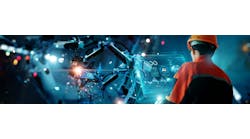Augmented reality lets the equipment help you diagnose the problem
How often have you heard this line? “I forget.”
Age is a wonderful thing, but the tagline should read: “If you don’t use it, you lose it.” We have all fallen into that trap at one time or another. Part of our growing problem is the aging of our workforce, which leads to knowledge transfer from your plant floor to the retirement home.
Much has been said about how we must get the knowledge out of the heads of us grey hairs and onto paper or, better yet, into the heads of the dark hairs (read much younger peeps).
Part of my automation career has been spent training automation engineering groups, as well as design and maintenance. We train on the devices and software that drive the processes, and quite often we train on the processes, as well.
But being trained on analog valve control or variable-speed-drive interfacing for Process A won’t be the same as that same process using different vendors’ devices.
Also read: Are our workstations ready for a virtual interface?
So we have manuals on everything from soup to nuts. You’ve seen them—oily, greasy paper manuals that always seem to be missing the page that you really need.
So, what about the mobile climate we live in? Can these manuals live in this environment, so that we have those missing pages at our fingertips? We’ve been doing that already.
But the last time I looked at this 15-year-old ac vector drive from Yaskawa was 15 years ago, when we commissioned it. The last drive I worked on was three years ago. We are making equipment so reliable that we hardly touch it until we have to.
So, what if I told you that there is a much better way that incorporates today’s technology with old-school thinking.
Enter augmented reality (AR). Catchy name, eh? But it isn’t new.
The Internet of Things brings to light an interesting platform. A device can be accessible on your network without being Internet-connected. Heck, if it is Bluetooth-enabled, then it is still part of the IoT phenomenon.
But imagine using a tablet with Bluetooth connectivity to access the device directly, kind of like a car’s computer or an airplane’s black box. Who knows better than the device itself? Ever wonder things like, “If that drive could talk, what would it tell me?”
With AR, the solutions are endless.
The demo I viewed was a motorcycle technician whose task was to fix a bike that was reported to have an engine malfunction. Using the camera on the tablet, he focused in on the AR symbol on the bike and, voila, the AR application for the bike began.
The software connects with the bike via Bluetooth and accesses the bike’s “black box,” if you will. The bike reported that the dingdong valve was acting up. Say what?
The technician pressed the ‘?’ on the tablet for a pathway to check and fix. The pattern recognition of the actual bike had 3D graphics superimposed on top of the real moving picture of the bike.
The software then highlighted the area of the bike where this valve was located. It was underneath a cowling. Who knew?
The software then proceeded to show the tech which screws to remove to access the valve and how to check it once exposed.
A long process was reduced to minutes. Time savings, as well as big dollar benefits, were realized.
So, imagine you have a VFD that could tell you what may be wrong. Remember that you are there in front of the device or panel because someone said there was an issue, or in fact the process told you that product was out of spec.
You connect to the VFD via Bluetooth and it tells you that the speed regulation was seen to vary too much. Now what?
You engage the historical database on the drive and see that no one has changed the set points, so it must be hardware- or feedback-related. You enable the AR application for that drive.
Based on the complaint from the drive, the AR software starts to map out your journey; you are the eyes and hands of this virtual troubleshooter. All of a sudden the need for knowledge transfer is reduced, and AR can take a competent, young, able-minded technician and make him a hero.
Lenze makes a smart motor where you can change the speed setting with your smart phone. The technology is there to implement AR, as well as any mobile data gathering applications to make smarter and quicker decisions and to diagnose and fix major issues like a champ.
As a vendor, developing these tools for your customers can be a huge selling point, but if all vendors provided this value-added feature set, then brand loyalty may go out the window into the retirement home.
Why does a sword always have to have two edges? HoloLens, here we come.
Homepage image courtesy of pixtawan at FreeDigitalPhotos.net






